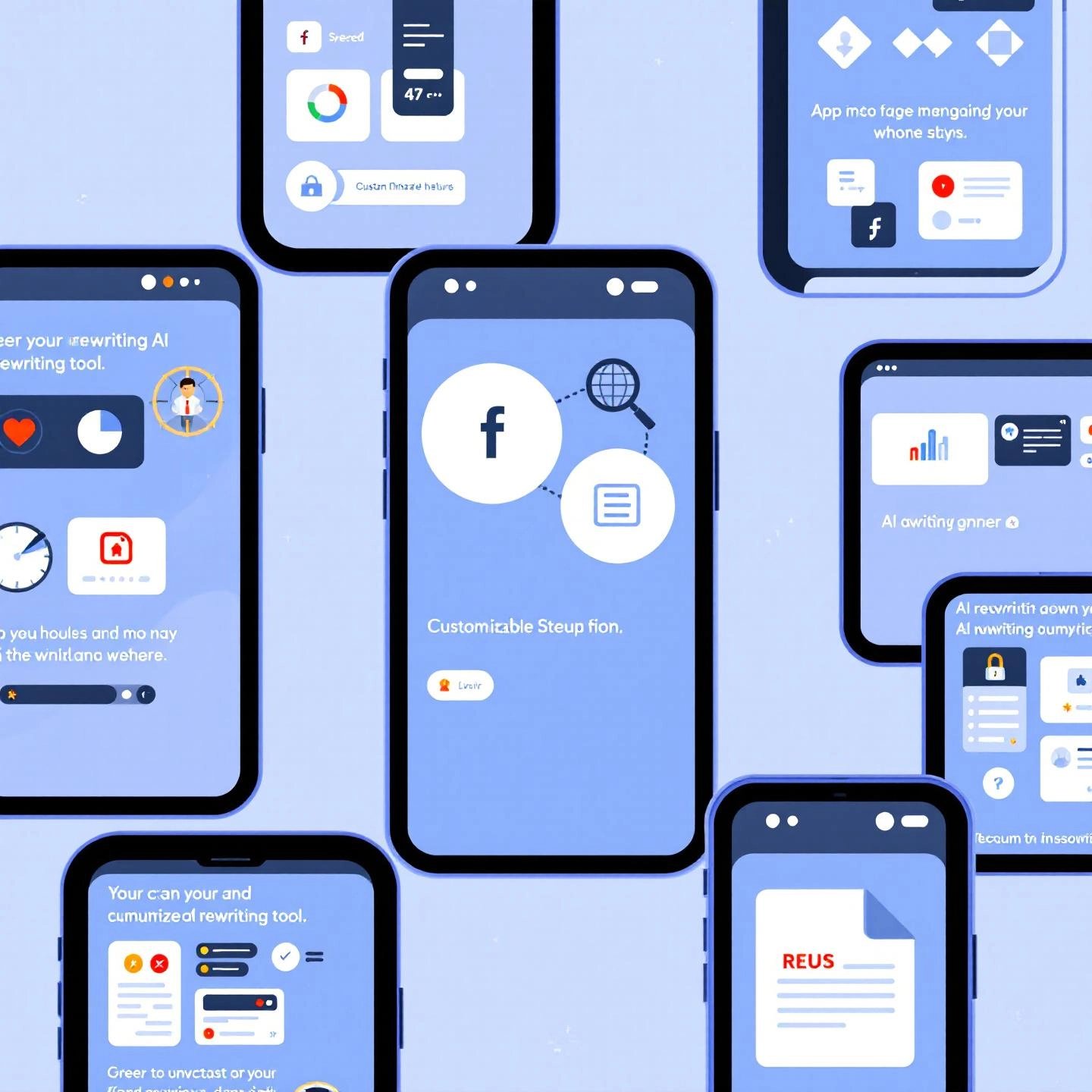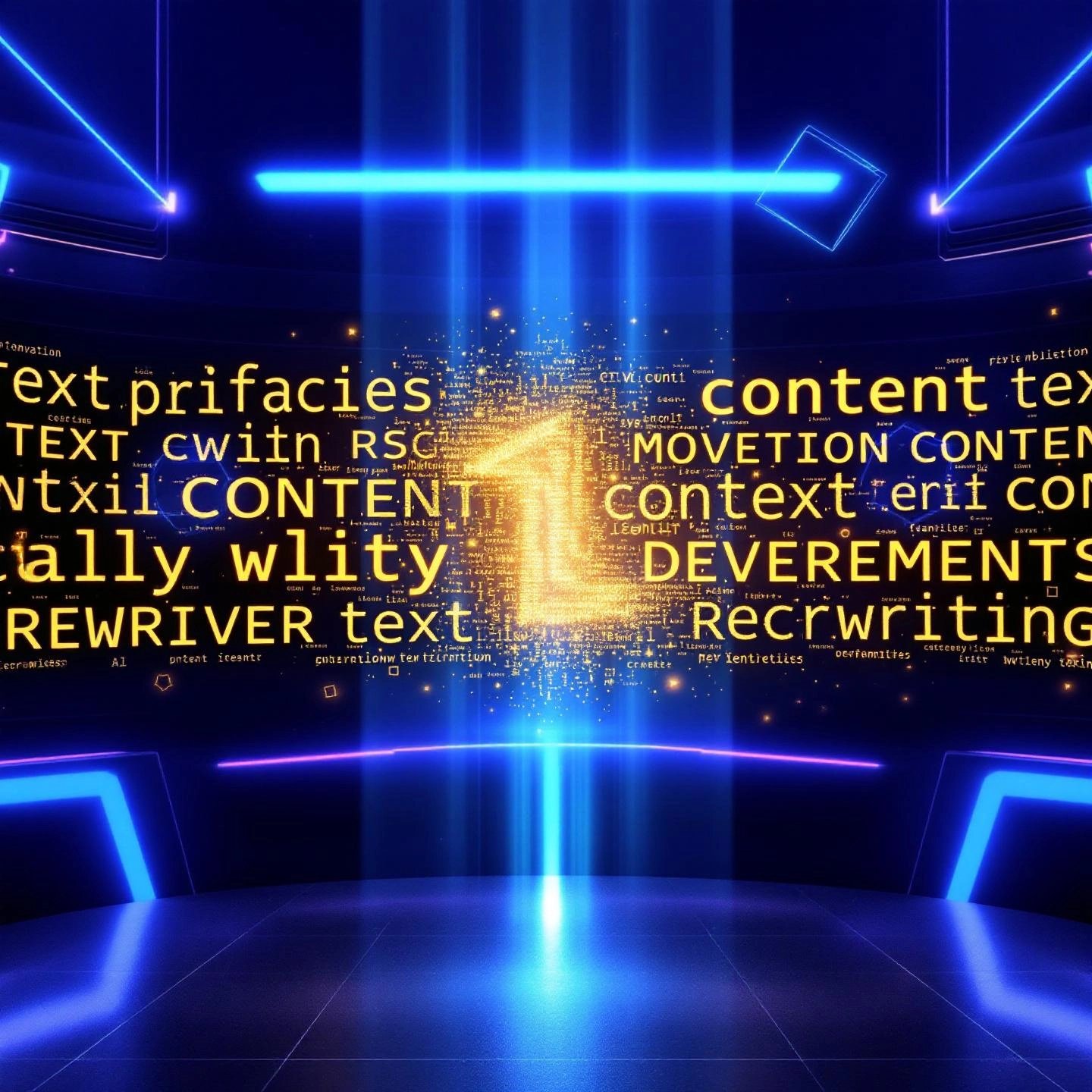Introduction to an AI Essay Rewriter
Ever stared at a blank page, unsure where to start? Or maybe you’ve finished a draft and wondered how to make it clearer, more original, or less likely to trigger plagiarism checkers. In today’s fast-paced academic and professional world, these scenarios are all too familiar. That’s where an ai essay rewriter comes in—a solution that’s reshaping how students, professionals, and content creators approach writing challenges.
What exactly is an AI essay rewriter? At its core, it’s software that uses artificial intelligence to paraphrase, rephrase, or even restructure existing text. These tools can take a passage you’ve written—or one you need to adapt—and transform it into new wording while preserving the original meaning. Sounds complex? In practice, it’s as simple as pasting your text into an ai essay rewriter online and letting advanced language models do the heavy lifting.
Why are these tools so relevant now? Consider these common scenarios:
- Students racing against deadlines, seeking to improve clarity or avoid unintentional plagiarism.
- Professionals repurposing reports or presentations for different audiences.
- Content creators aiming to refresh old blog posts or adapt material for new channels.
People turn to AI-powered rewriting for several reasons:
- Clarity and readability: Make complex ideas easier to grasp.
- Originality: Avoid plagiarism by generating unique phrasing.
- Efficiency: Overcome writer’s block and save valuable time (MWWire).
But not all users have the same goals. For some, simple paraphrasing is enough—just a new spin on the same message. For others, the priority is to bypass AI detection tools increasingly used by schools and search engines to flag automated writing.
This article will guide you through the evolving landscape of AI essay rewriters. You’ll discover how these tools work, the risks and ethical considerations involved, and how to choose the right solution—whether you’re looking for a quick, free tool or a more robust, professional service. Along the way, you’ll get practical tips to ensure your writing remains both effective and authentic in the age of artificial intelligence.

Understanding How AI Essay Rewriters Work
Ever wondered what really happens when you click “rewrite” on an AI tool? If you’ve used an ai essay rewriter and marveled at how quickly your text transforms, you’re not alone. But beneath the surface, there’s some impressive technology at play. Let’s break down how these tools actually work, why they’re so powerful, and what you should keep in mind as you use them.
The Core Mechanisms: From Simple Swaps to Deep Language Understanding
At its most basic, ai for rewriting essays relies on a few core techniques:
- Synonym Replacement: Swapping out words for others with similar meanings. For example, “important” might become “crucial.”
- Sentence Restructuring: Changing the order or construction of a sentence to say the same thing in a new way. For instance, “Students use these tools to save time” could become “To save time, these tools are used by students.”
- Natural Language Processing (NLP): Using advanced algorithms that understand context, meaning, and tone to generate text that feels human—not robotic.
But not all AI rewriters are created equal. Some use very basic approaches, while others leverage the latest breakthroughs in artificial intelligence.
Three Levels of AI Essay Rewriting Technology
Imagine you’re shopping for a new car. Some models are simple and reliable, while others are packed with high-tech features. The same goes for AI essay rewriters. Here’s how the technology stacks up:
- Basic Spinners
- Old-school tools that mainly swap out synonyms.
- Often result in awkward or unnatural phrasing.
- Best for quick, low-stakes rewrites but can miss context.
- Advanced Paraphrasers
- Use more sophisticated NLP to restructure sentences and adjust word choice.
- Better at preserving meaning and tone.
- Can adapt writing style to some extent, making text more readable and unique.
- Generative AI Models
- Leverage large language models (LLMs) trained on billions of examples.
- Understand context across entire essays, not just isolated sentences.
- Produce nuanced, coherent, and stylistically flexible writing that can mimic human authorship.
- Regularly updated to improve accuracy and reduce errors.
The Process: How AI Turns Your Input Into Unique Output
When you submit text to an ai essay rewriter, here’s what typically happens:
- Input Analysis: The AI scans your text, identifying key ideas, tone, and structure.
- Context Building: Advanced models create a “working memory” of the topic, helping them stay on track as they rewrite.
- Generation: The tool generates new text, one word or phrase at a time, guided by patterns it learned from vast language data.
- Review and Refinement: The best tools review their own output, making tweaks for clarity, coherence, and style.
- Formatting: The final result is delivered in essay form, often matching your requested style or requirements.
Sounds smart? It is. But remember, even the most advanced AI doesn’t truly “understand” your topic—it’s making predictions based on patterns, not personal insight (IntelligentHQ).
Capabilities and Limitations: What AI Rewriters Can and Can’t Do
- Strengths: Speed, consistency, and the ability to generate unique wording for large volumes of text.
- Limitations: May misinterpret complex or nuanced ideas, struggle with technical jargon, or occasionally produce awkward phrasing. Human review is still essential for accuracy and tone.
As you continue exploring, keep in mind that using ai for rewriting essays is about balance—combining the efficiency of AI with your own critical thinking and editing skills. Next, we’ll look at a major challenge: how AI-generated text interacts with detection tools and what that means for your academic or professional integrity.
How to Rewrite Essays to Avoid AI Detection
Ever wondered why so many students and professionals worry about using an ai essay rewriter? The answer often comes down to one thing: the fear of being caught by AI detection tools. Whether you’re submitting an academic paper or publishing content online, the possibility of your work being flagged as AI-generated can have serious consequences. Let’s break down how these detectors work, what’s at stake, and why simply running your text through a standard rewriter may not be enough.
What Are AI Detection Tools—and Why Do They Matter?
Imagine you’ve just finished rewriting your essay with an AI tool. You hit submit, feeling confident. But behind the scenes, your school or publisher may run your work through an AI detector—a specialized software designed to spot the telltale signs of machine-generated writing. These tools are now widely used in education and online publishing to uphold integrity and filter out unoriginal or automated content.
- Academic Institutions: Use AI detectors to ensure student work is original and reflects true learning.
- Search Engines: May downrank or penalize websites that rely heavily on AI-generated content, impacting visibility and SEO.
How AI Detectors Spot Automated Text
Sounds complicated? In practice, AI detectors look for patterns that are hard for humans to spot but easy for algorithms to catch. Here’s what they typically analyze:
- Digital Fingerprints: AI-generated text often has subtle traits—like repetitive phrasing, predictable sentence structures, or unnatural transitions.
- Statistical Patterns: Detectors compare your text to massive databases of known AI outputs, searching for similarities in word choice, syntax, and flow.
- Content Probability: Tools like Originality.ai assign a score based on how likely it is that your essay was written by a machine, sometimes highlighting specific sentences as suspicious.
Even if you use an essay rewriter no ai detection promise, most tools still rely on algorithms that can leave behind these digital footprints.
What Happens If You Get Flagged?
Imagine the fallout if your rewritten essay is tagged as AI-generated:
- Academic Penalties: Schools may issue failing grades, academic probation, or even expulsion for suspected AI use, especially if it’s seen as a form of plagiarism.
- Loss of Credibility: For professionals and content creators, being flagged can damage your reputation and erode trust with readers or employers.
- Poor SEO Performance: Search engines may penalize or de-rank pages that appear to be mass-produced by AI, reducing your reach and impact.
These risks highlight why so many users search for ways to rewrite essay to avoid ai detection—but it’s not always as simple as using a different tool or running your text through another rewriter.
Why Standard AI Rewriters Aren’t Always Enough
Think using any ai essay rewriter will make your content undetectable? Not quite. Most AI-powered rewriters, even those claiming to bypass detection, still rely on similar underlying technology. This means your text may still trigger red flags for advanced detectors. In fact, some tools that advertise as an essay rewriter no ai detection simply use basic synonym replacement or minor sentence shuffling—changes that modern detectors can easily spot.
To truly lower your risk, you’ll need to go beyond automated rewriting. Human editing—adding personal insights, varying sentence structure, and double-checking facts—remains the most effective way to ensure your work passes scrutiny. The next chapter will help you compare popular free AI essay rewriters, but keep in mind: for high-stakes situations, a thoughtful, human touch is still your best defense against detection.

Exploring Top Free AI Essay Rewriter Tools
Ever searched for a free ai essay rewriter only to be overwhelmed by choices? With so many tools promising to rewrite my essay ai free, how do you know which one will actually deliver clear, authentic, and effective results? Let’s break down the most popular options so you can pick the right fit for your workflow, whether you’re a student on a deadline, a blogger refreshing old posts, or a professional looking to polish reports.
What Should You Look for in a Free AI Essay Rewriter?
Before jumping into the comparison, ask yourself: What matters most for your project? Is it ease of use, depth of rewriting, or extra features like grammar checks and plagiarism detection? Here are some key factors to consider:
- Natural Language Output: Does the tool create text that sounds human, not robotic?
- Customization: Can you adjust tone, style, or complexity?
- Speed and Simplicity: Is the interface intuitive for quick turnarounds?
- Additional Features: Does it offer grammar checks, plagiarism detection, or integration with other platforms?
- Word Count Limits: Are there restrictions on how much you can rewrite at once?
Now, let’s see how the leading tools stack up.
Comparison Table: Free AI Essay Rewriter Tools
| Tool Name | Key Feature | Ease of Use | Best For |
|---|---|---|---|
| BlogSpark.ai | AI-powered rewriting with SEO focus and customizable brand voice | Intuitive interface, quick setup, and seamless workflow | Bloggers, marketers, and professionals seeking high-quality, SEO-optimized rewrites |
| QuillBot | Multiple rewriting modes (Standard, Fluency) and built-in thesaurus | Extremely user-friendly; no sign-up needed for basic use | Students and writers wanting quick, flexible paraphrasing options |
| Grammarly | AI-powered rewriting plus grammar and clarity suggestions | Seamless browser integration and real-time feedback | Anyone needing grammar checks alongside essay rewriting |
| Paraphrase Online | Fast, straightforward paraphrasing for quick rewrites | Minimalist design; just paste and go | Users on tight deadlines or those needing basic, instant results |
Tool-by-Tool Highlights
- BlogSpark.ai: Goes beyond basic rewriting by offering SEO optimization, customizable brand voice, and a streamlined workflow—ideal for users who want more than just a quick paraphrase (BlogSpark.ai).
- QuillBot: Known for its flexible rewriting modes and instant, no-login access. Great for academic or casual use when you need several options for tone and fluency.
- Grammarly: Combines AI rewriting with advanced grammar and clarity checks, making it perfect for polishing drafts and ensuring correctness.
- Paraphrase Online: Offers a no-frills, fast solution for quick rewrites—simple to use but best for short, straightforward content.
How to Choose the Best Free AI Essay Rewriter for You
Imagine you’re facing a tight deadline and need a tool to rewrite my essay ai free—speed and simplicity might be your top priorities. But if you’re working on content that needs to rank in search engines or reflect a specific brand voice, a solution like BlogSpark.ai will provide more value. For academic essays, QuillBot’s flexibility and Grammarly’s editing features can help you meet quality standards without extra hassle.
Ultimately, the best free ai essay rewriter is the one that fits your unique needs. Start by identifying your goals—clarity, originality, SEO, or speed—and match them to the tool that delivers on those fronts. In the next section, we’ll look at why even the best free tools have their limits, and what to watch out for as you rely on AI to rewrite your work.
Why "Free" Often Comes at a Cost
Tempted to use a free tool to rewrite my essay without ai detection free? You’re not alone. Free AI essay rewriters can be a lifesaver when you need quick results, have a tight budget, or just want to experiment with new technology. But before you rely on these tools for high-stakes assignments or professional writing, it’s important to understand the trade-offs that come with "no-cost" solutions.
What You Gain—and What You Sacrifice—with Free AI Essay Rewriters
Imagine you’ve just found a tool that promises to transform your essay in seconds, no credit card required. Sounds perfect, right? But as you dig deeper, you’ll notice some recurring challenges that can impact the quality, safety, and originality of your work. Here’s what to watch out for:
- Higher Risk of AI DetectionFree tools often use older or less sophisticated language models. These models may leave behind the digital fingerprints that AI detectors are designed to spot, making it much harder to truly rewrite my essay without ai detection free. If your goal is to avoid AI detection, free tools are rarely a safe bet.
- Potential for PlagiarismBecause free AI rewriters usually pull from publicly available data and may not always rephrase content deeply, there’s a real risk that your essay could contain passages too similar to existing sources. This can lead to unintentional plagiarism—a major concern in both academic and professional settings (ICS Learn).
- Grammatical Errors and Awkward PhrasingWhile some free tools can handle basic rewording, they often struggle with complex sentence structures or nuanced language. The result? Essays that sound robotic, contain grammar mistakes, or don’t flow naturally—issues that require extra editing to fix.
- Strict Word and Usage LimitsMany free rewriters cap the number of words you can process in a single session, or limit how many times you can use the tool each day. This can be especially frustrating if you’re working on longer assignments or need to revise multiple drafts.
- Intrusive Ads and Upsell PromptsFree tools often display ads or push you toward paid upgrades. These interruptions can slow down your workflow and make the writing process less enjoyable.
- Privacy and Data ConcernsWhen you use a free AI rewriter, your text may be stored or used to train future models. In some cases, your data could be shared with third parties or used for advertising purposes. If you’re dealing with sensitive or confidential information, this is a serious risk.
Why "Rewrite My Essay Without AI Detection Free" Isn’t a Guarantee
It’s easy to search for a tool that promises to rewrite my essay without ai detection free, but in reality, most free solutions simply can’t deliver on this promise. Their limited technology means your content may still be flagged by sophisticated AI detectors, especially in academic or professional environments where the consequences are serious. Even if a tool claims to bypass detection, it rarely provides the depth of rewriting or human-like nuance needed to truly pass scrutiny.
When Are Free Tools Still Useful?
Despite their drawbacks, free AI rewriters do have their place. They’re helpful for:
- Generating quick drafts or brainstorming new ways to phrase an idea
- Editing short, low-stakes texts where originality and privacy aren’t top concerns
- Experimenting with AI capabilities before committing to a paid service
But for important essays, sensitive documents, or anything that must pass AI detection, it’s wise to approach free tools with caution. In the next chapter, you’ll discover practical ways to humanize AI-generated content and reduce your risk—regardless of which tool you use.

Best Practices for Humanizing AI-Rewritten Content
Ever read something and thought, “This sounds a bit... robotic?” If you’ve used an ai essay rewriter, you may have noticed that while the text is grammatically correct, it sometimes lacks the warmth, nuance, or personal touch of human writing. So, how do you take AI-generated drafts and make them truly yours—undetectable, authentic, and engaging? Let’s break down the essential steps for how to rewrite an ai generated essay so it passes both AI detectors and the all-important human test.
Why Humanizing Matters: Beyond AI Detection
AI can churn out essays in seconds, but readers (and detectors) can often spot patterns—predictable sentence structures, repetitive phrases, or a tone that feels generic. Humanizing your content isn’t just about avoiding detection. It’s about building trust, sharing your perspective, and ensuring your writing resonates with your audience.
Step-by-Step: Transforming AI Text into Human Writing
Ready to make your AI-rewritten essay sound like you? Here’s a practical, actionable approach:
- Check for Factual Accuracy and ContextDon’t assume the AI got every detail right. Review the text for subtle inaccuracies, outdated facts, or statements that don’t fit your assignment or audience. For example, if the AI says, “This technology is less than a decade old,” make sure that’s actually true for your topic.
- Vary Sentence Structure and RhythmAI often produces sentences of similar length and style, making the writing feel flat. Mix things up:
- Start some sentences with transition words or questions.
- Break up long sentences; combine short ones for flow.
- Use a mix of simple, compound, and complex sentences.
Example: Instead of, “AI is used in many industries. It is changing the way we work,” try, “AI is reshaping countless industries—how many can you name? From healthcare to finance, its impact is everywhere.”
- Inject Your Personal Voice and ExperienceAdd a story, opinion, or anecdote. Even a brief reflection or rhetorical question can make a difference. Imagine you’re explaining the topic to a friend: what would you emphasize? How would you phrase it?
- Share a relevant personal example or observation.
- Use conversational phrases or humor where appropriate.
- Express your stance (“In my experience,” “I believe,” “One thing I’ve noticed…”).
Tip: Even a single sentence of personal insight can transform a paragraph from generic to genuine.
- Refine Tone and Word ChoiceAI can default to formal or overly technical language. Adjust the tone to match your audience:
- Simplify jargon for general readers, or elevate language for academic or professional contexts.
- Replace overused AI words (like “crucial,” “enhance,” “resonate”) with your own vocabulary.
- Use adjectives, sensory details, or emotional language to create a vivid impression.
- Add Depth: Fact-Check and ExpandAI-generated content can be surface-level. Go deeper:
- Research and add a supporting fact, statistic, or quote.
- Provide context or explain why a point matters.
- Challenge or elaborate on the AI’s statements, offering your own perspective.
- Read Aloud and Edit for Natural FlowThis simple step is surprisingly powerful. Reading your essay out loud will help you catch awkward phrasing, unnatural transitions, or sections that don’t sound like you. If it feels stiff or repetitive, revise until the words flow smoothly.
- Proofread for Errors and ConsistencyEach edit introduces a chance for typos or inconsistencies. Use grammar checkers, but also trust your own review to ensure the final draft is polished and cohesive.
Quick-Reference Checklist: Humanizing Your AI Essay
- Does every fact check out?
- Is the sentence structure varied and engaging?
- Have you added personal voice or perspective?
- Is the tone right for your audience?
- Did you add depth or context?
- Does the essay sound natural when read aloud?
- Is the final version free of errors?
By following these steps, you’ll not only reduce the risk of AI detection but also ensure your work stands out as original and relatable. Next, we’ll compare free and paid rewriting solutions, so you can decide which approach best fits your academic or professional needs.
Paid vs. Free
When the stakes are high—think final papers, business proposals, or content that represents your brand—choosing between a free ai essay rewriter and a paid solution isn’t just about saving a few dollars. It’s about protecting your reputation, ensuring originality, and getting results you can trust. But what, exactly, do you get when you upgrade to a paid tool? And when does a free option suffice? Let’s break it down with a clear, side-by-side comparison.
Which Is Right for You: Free or Paid AI Essay Rewriters?
Imagine you’re on a deadline: do you risk it with a basic tool, or invest in a premium solution? The answer depends on your needs. Here’s a quick comparison to help you decide:
| Feature | Free Tools | Paid Tools/Services |
|---|---|---|
| Quality of Output |
|
|
| AI Detection Risk |
|
|
| Originality/Plagiarism Score |
|
|
| Customization Options |
|
|
| Support |
|
|
Why Paid Rewriters Stand Out for High-Stakes Needs
Still wondering if investing in the best ai essay rewriter is worth it? Consider these real-world scenarios:
- Academic Integrity: Paid tools often include plagiarism detection and citation features, helping you meet strict university standards and avoid accidental misconduct.
- Professional Reputation: For business, marketing, or publishing, the quality of your writing reflects on your brand. Premium solutions deliver polished, on-brand content that’s less likely to be flagged or rejected.
- Efficiency and Scale: Paid tools remove word count caps, speed up workflows, and allow for larger or more complex projects—crucial if you’re producing content regularly or at scale.
- Privacy and Security: Sensitive data is less likely to be used for model training or shared with third parties, giving you peace of mind for confidential work.
When Does a Free AI Essay Rewriter Make Sense?
- Short, low-stakes assignments or personal projects
- Testing AI capabilities before committing to a subscription
- Brainstorming, outlining, or rough drafts where quality isn’t critical
But for anything that impacts your grades, reputation, or business results, paid tools offer peace of mind and higher quality—making them a smart investment for serious writers.
Ready to step up your game? In the next section, you’ll find a practical checklist to help you choose the right rewriting solution for your goals and workflow.
A Final Checklist for Choosing Your AI Rewriter Solution
Feeling overwhelmed by all the options and considerations for selecting an ai rewriter? When you need to rewrite text—whether for an essay, a report, or a blog post—a clear plan can help you pick the right tool and approach. Here’s a practical checklist to guide your decision, so you can move forward with confidence and avoid common pitfalls.
| Decision Point | What to Ask Yourself | Why It Matters |
| Primary Goal | Are you aiming for clarity, originality, SEO, or bypassing AI detection? | Clarifies which features and tools to prioritize—some excel at paraphrasing, others at undetectability or optimization. |
| Budget | Will a free tool suffice, or do you need premium features? | Free tools are great for quick drafts; paid solutions offer advanced rewriting, privacy, and support for high-stakes needs. |
| Quality Requirements | Does your project demand polished, nuanced writing or just basic rewording? | For academic, business, or published content, higher-quality output is essential. Quick rewrites may be fine for personal use. |
| Plagiarism/AI Detection Testing | Will you check your rewritten text with plagiarism or AI detectors? | Testing ensures your work is truly unique and less likely to be flagged—especially important in academic and professional settings. |
| Voice Authenticity | Does the output sound like you, or is it obviously machine-generated? | Personalizing your writing with your own style and insights helps avoid detection and builds trust with your audience. |
Quick-Reference Action Steps
- Define your main objective before choosing an ai rewriter.
- Set a realistic budget—free tools are fine for low-risk tasks; invest for high-stakes work.
- Match the tool’s capabilities to your quality needs—don’t expect deep nuance from basic solutions.
- Always run plagiarism and AI detection checks on your final draft.
- Edit for voice and flow: read your work aloud, add personal stories, and refine awkward phrasing.
Imagine you’re about to submit a critical essay or publish a business post. By running through this checklist, you’ll avoid last-minute surprises and ensure your rewritten text meets your goals for clarity, originality, and authenticity. Up next, we’ll explore when it makes sense to go beyond rewriting and consider full-service content solutions for even greater impact.

Beyond a Simple AI Essay Rewriter for Business and Professionals
Ever tried to use an ai essay rewriter for business content, only to realize something was missing? Maybe the text was clear, but it didn’t sound like your brand. Or perhaps you needed a thought leadership article that truly stood out, not just a reworded version of existing ideas. If you’ve been there, you already know: even the best AI rewriter has its limits—especially when your goals go beyond basic paraphrasing.
Why Standard AI Rewriting Isn’t Enough for Strategic Content
Imagine you’re launching a new product, building your professional reputation, or aiming to rank for competitive SEO keywords. In these scenarios, generic rewriting tools can only take you so far. Here’s when you’ll want to look beyond simple AI rewriters:
- Brand-Aligned Messaging: Your business voice is unique. Automated tools often miss subtle cues—tone, style, and messaging consistency—that are critical for building trust and authority.
- Thought Leadership: To establish expertise, you need original insight, industry-specific research, and a narrative that resonates with your audience. AI can rephrase, but it can’t synthesize new perspectives or conduct interviews with your team.
- SEO and Content Strategy: High-impact content isn’t just about words—it’s about targeting the right keywords, structuring posts for search, and integrating calls-to-action that drive results. AI rewriters may optimize text, but they rarely deliver a full-funnel content plan.
- Guaranteed Originality: For high-stakes publishing or business-critical projects, you need assurance that your content is truly unique and free from hidden AI fingerprints or plagiarism risks.
When to Consider Full-Service Content Creation
So, when should you move from DIY rewriting to outsourcing your content? Here are clear signals:
- You need a steady flow of high-quality blog posts, landing pages, or long-form assets that reflect your business goals.
- Your team lacks the time or expertise to execute a data-driven SEO strategy, keyword research, and ongoing optimization.
- You want to scale content production without sacrificing quality, originality, or brand alignment.
- Your industry demands subject matter expertise, regulatory compliance, or in-depth research that goes beyond what AI can deliver.
In these cases, outsourcing isn’t just about saving time—it’s about elevating your results and ensuring every piece of content moves the needle for your business or professional brand.
Meet BlogSpark: End-to-End Content Creation for Business and Professionals
This is where a solution like BlogSpark comes in. Unlike standalone AI rewriters, BlogSpark offers a comprehensive platform that covers every stage of the content lifecycle—from strategy and keyword discovery to drafting, optimization, and publishing. Here’s how it stands out for ai essay rewriter for professionals and business users:
- Strategic Planning: Built-in keyword research and SEO outlining ensure your content is targeted, relevant, and designed to rank.
- Custom Brand Voice: Advanced customization lets you maintain a consistent brand tone across every article.
- Originality and Quality: Integrated originality checks and human-in-the-loop editing help guarantee your content is both unique and credible.
- Workflow Integration: Direct exports and platform integrations (like WordPress) streamline your publishing process, saving your team hours every week.
- Scalability: Whether you’re a solo professional or a growing agency, BlogSpark adapts to your needs—making it easy to ramp up production without losing quality.
Imagine handing off your content needs to a platform that not only rewrites but also strategizes, optimizes, and ensures your message is heard. For businesses and professionals ready to move beyond simple rewriting, BlogSpark provides the expertise and tools to turn ideas into influence—and influence into measurable growth.
Up next, we’ll wrap up with a summary of the key takeaways and a call-to-action for making your next move in smarter, safer essay rewriting.
Conclusion
Imagine you’re at the end of your writing journey—your essay is drafted, but you’re still unsure if it’s clear, original, or safe from AI detection. That’s where everything we’ve covered comes together. Let’s recap the key lessons so you can confidently select the best ai essay rewriter for your goals.
- Know How AI Essay Rewriters Work: These tools use advanced language models to paraphrase, restructure, and refine your text. They’re fast and efficient, making them ideal for overcoming writer’s block or refreshing existing content.
- Understand the Risks: While convenient, AI-generated text can sometimes be flagged by detection tools. This can lead to academic penalties, SEO challenges, or loss of credibility—especially if you rely solely on automated rewriting.
- Free vs. Paid vs. Professional Services: Free tools are great for quick drafts and low-stakes projects, but they often come with limits—like higher AI detection risk, basic output, and privacy concerns. Paid solutions offer deeper customization, better support, and stronger protection against plagiarism or detection. For mission-critical content, professional services like BlogSpark deliver end-to-end strategy, originality checks, and seamless workflow integration.
Take Action: Match the Tool to the Task
Before you hit “rewrite,” ask yourself:
- Is this a simple assignment or a high-stakes project?
- Do you need basic paraphrasing, or a unique, brand-aligned message?
- Will your work be checked by AI or plagiarism detectors?
For everyday tasks, an ai essay rewriter can save time and spark new ideas. But when your reputation, grades, or business results are on the line, investing in the best ai essay rewriter—or a full-service solution like BlogSpark—will help you stand out with confidence and credibility.
Ready to elevate your writing? Start with the right tool for your needs—and don’t hesitate to reach for expert support when it matters most.
Frequently Asked Questions About AI Essay Rewriters
1. Is there an AI that can rewrite essays?
Yes, several AI-powered tools like BlogSpark.ai, QuillBot, and Grammarly offer essay rewriting features. These platforms use advanced language models to paraphrase, restructure, and enhance your text, making it more original and readable. Some tools also allow customization of tone and style to better fit your needs.
2. Can AI essay writers be detected?
AI-generated essays can often be detected by specialized tools that analyze writing patterns, syntax, and digital fingerprints. While some AI rewriters claim to bypass detection, human editing and personalization are still critical for reducing the risk of being flagged, especially in academic or professional contexts.
3. What's the best AI rewriter?
The best AI rewriter depends on your needs. BlogSpark.ai is ideal for SEO-focused, brand-consistent content, while QuillBot and Grammarly are popular for academic and general use due to their flexible rewriting modes and grammar checks. Paid solutions typically offer more advanced features and better detection avoidance.
4. How can I make AI-rewritten content undetectable?
To make AI-rewritten content less detectable, vary sentence structure, add personal insights, fact-check details, and refine the tone to match your authentic voice. Manual editing after using an AI tool is essential to ensure originality and reduce recognizable AI patterns.
5. Are free AI essay rewriters safe to use?
Free AI essay rewriters are useful for quick drafts or brainstorming but come with risks like higher AI detection rates, potential plagiarism, limited features, and privacy concerns. For important academic or business work, consider paid or professional solutions for better quality and security.




